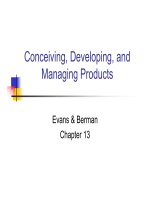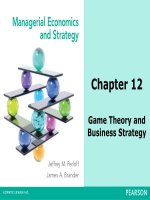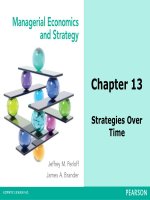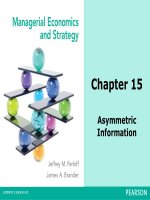Career development interventions 5th by spence niles and bowlsbey chapter 13
Bạn đang xem bản rút gọn của tài liệu. Xem và tải ngay bản đầy đủ của tài liệu tại đây (192.42 KB, 28 trang )
Career Development Interventions
5th Edition
Spence G. Niles and JoAnn E. Harris-Bowlsbey
Publisher to insert
cover image here
Chapter 13
Career Development
Interventions in Higher Education
Developed by:
Jennifer Del Corso
Copyright © 2017, 2013, 2009 by Pearson Education, Inc. All Rights Reserved
Career Needs of Students in
Higher Education
• In 2011, slightly 21 million students were enrolled
in postsecondary education in the United States.
• In October 2013m 65.9% of 2013 high school
graduates enrolled in colleges and universities.
• College enrollment rates of Asians (79.1%) is
highest compared to White (67.1%), Black (59.3%)
and Hispanic (59.9%)
• The unemployment rate for high school graduates
not enrolled in college was 30.9%
Career Development Interventions, 5th Edition
Spencer G. Niles and JoAnn E. Harris-Bowlsbey
Copyright © 2017, 2013, 2009 by Pearson Education,
Inc.
All Rights Reserved
Changing Landscape of Higher EdEnrollment
• Women made up 57% (about 12 million) of undergraduate
student population in 2014, with just over 9 million men
enrolled (NCES)
• International students are another group that represents a
substantial percentage of those enrolled in higher education.
There were approximately 886,052 international students
enrolled in higher education in the United States in 2014
• Ethnic minorities made up 32% of students in higher education
in 2007.
• In a recent survey of 90,000 college students (2012), 3%
identified as gay/lesbian, 1.9% unsure, and 0.2% transgender.
Career Development Interventions, 5th Edition
Spencer G. Niles and JoAnn E. Harris-Bowlsbey
Copyright © 2017, 2013, 2009 by Pearson Education,
Inc.
All Rights Reserved
Changing Landscape of Higher EdGraduation Rates
• Only 19% of students enrolled in 4-year bachelor’s
degrees at nonflagship colleges; 36% from flagship or
very high research universities, graduate in four years
(Complete College America, 2014).
• Only 59% graduate in six years (NCES, 2014) despite
83.4% believing they will graduate in four yearsmismatch in expectations and a need for more
preparation
Career Development Interventions, 5th Edition
Spencer G. Niles and JoAnn E. Harris-Bowlsbey
Copyright © 2017, 2013, 2009 by Pearson Education,
Inc.
All Rights Reserved
Changing Landscape of Higher
Education
• Survey results from the Higher Education Research Institute
(2012) indicate that most first-year college students (87%)
indicate that they chose to attend college to “get a better
job” and 75% report that they chose to attend college “to
make more money”
• Project on Student Debt (Kingkade, 2014) reports that 69%
of students graduating in 2013 from four-year colleges and
universities had student-loan debt.
• Average debt levels for graduate seniors is $28,400 in 2013
• 11.8% of all 18 to 24 year olds enroll in community college
Career Development Interventions, 5th Edition
Spencer G. Niles and JoAnn E. Harris-Bowlsbey
Copyright © 2017, 2013, 2009 by Pearson Education,
Inc.
All Rights Reserved
The Evolution of Career
Development Interventions
• Professor/advocate
• Job placement
• Employment agencies
• Placement offices
• Diverse services (no single type of counseling
center or placement center)
Career Development Interventions, 5th Edition
Spencer G. Niles and JoAnn E. Harris-Bowlsbey
Copyright © 2017, 2013, 2009 by Pearson Education,
Inc.
All Rights Reserved
Five Major Approaches for
Delivering Career Services
• Macrocenter
• Counseling orientation
• General-level service
• Career planning and placement
• Minimal service
Career Development Interventions, 5th Edition
Spencer G. Niles and JoAnn E. Harris-Bowlsbey
Copyright © 2017, 2013, 2009 by Pearson Education,
Inc.
All Rights Reserved
Why College Students Seek Career
Assistance
• Learn more about themselves
• Identify career goals
• Become more certain of their career plans
• Explore career options
• Do educational planning
• Learn job search skills
Career Development Interventions, 5th Edition
Spencer G. Niles and JoAnn E. Harris-Bowlsbey
Copyright © 2017, 2013, 2009 by Pearson Education,
Inc.
All Rights Reserved
Career Development
Competencies in Adulthood
• Personal Social Development
• Educational Achievement and Lifelong learning
• Career Management
Career Development Interventions, 5th Edition
Spencer G. Niles and JoAnn E. Harris-Bowlsbey
Copyright © 2017, 2013, 2009 by Pearson Education,
Inc.
All Rights Reserved
Personal Social Development
• Career service providers can help students with the
following personal development goals:
1) develop understanding of self and maintain a
positive self-concept;
2) develop positive interpersonal skills, including
respect for diversity,
3) integrate growth and change into your career
development, and
4) balance personal, leisure, community, learner,
family, and work roles
Career Development Interventions, 5th Edition
Spencer G. Niles and JoAnn E. Harris-Bowlsbey
Copyright © 2017, 2013, 2009 by Pearson Education,
Inc.
All Rights Reserved
Educational Achievement and
Lifelong Learning
• Career service providers can help students obtain
educational achievement and life learning by:
Helping students know how to access and use the
information they gather in their educational and
occupational career exploration
Helping student develop strategies for overcoming
obstacles in their career path (e.g. childcare, financial
costs)
Offering career planning courses to assist students in
long and short range career plans
Providing career information via courses, workshops and
small groups
Career Development Interventions, 5th Edition
Spencer G. Niles and JoAnn E. Harris-Bowlsbey
Copyright © 2017, 2013, 2009 by Pearson Education,
Inc.
All Rights Reserved
Career Management
• Career service providers can help students reach their career
management goals by helping students:
Create and manage a career plan that meets their career
goals
Use a process of decision making as one component of career
development
Use accurate, current, and unbiased career information during
career planning and management
Master academic, occupational, and general employability
skills in order to obtain, create, maintain, and/or advance your
employment
Integrate changing employment trends, societal needs, and
economic conditions into their career plans
Career Development Interventions, 5th Edition
Spencer G. Niles and JoAnn E. Harris-Bowlsbey
Copyright © 2017, 2013, 2009 by Pearson Education,
Inc.
All Rights Reserved
Goals of Career Interventions in
Higher Education
• Help students learn to identify and transfer career
interests to a plan of action
• Help students relate interests and goals to
opportunities
• Help students relate their career plans to life goals and
opportunities
• Help students learn how to evaluate their progress
toward career goals through academic preparation
Career Development Interventions, 5th Edition
Spencer G. Niles and JoAnn E. Harris-Bowlsbey
Copyright © 2017, 2013, 2009 by Pearson Education,
Inc.
All Rights Reserved
Career Interventions in Higher
Education (Crites’ Model)
• Explore a variety of options.
• Crystallize a narrow range of specific options.
• Make a commitment to a choice and specify
college major.
• Implement the choice of major.
Career Development Interventions, 5th Edition
Spencer G. Niles and JoAnn E. Harris-Bowlsbey
Copyright © 2017, 2013, 2009 by Pearson Education,
Inc.
All Rights Reserved
Powell and Kirts Model
• Proposes a systems approach to career services
in higher education
• Starts by providing an overview of services to
new students
• Continues by providing self-assessment
• Then focuses on exposure as students engage
actively in career exploration
• Finally provides training in job search skills
Career Development Interventions, 5th Edition
Spencer G. Niles and JoAnn E. Harris-Bowlsbey
Copyright © 2017, 2013, 2009 by Pearson Education,
Inc.
All Rights Reserved
The Florida State Model
• A curricular career information service (CCIS)
model with five modules, as follows:
Introduction to the service
Orientation to the decision-making
process
Self-assessment
Career information
Matching of majors and jobs
Career Development Interventions, 5th Edition
Spencer G. Niles and JoAnn E. Harris-Bowlsbey
Copyright © 2017, 2013, 2009 by Pearson Education,
Inc.
All Rights Reserved
Sampson Model (2008)
• Eight-step model which begins by evaluating and
assessing career resources and services.
• Based on the initial assessment, career resources
and services are adapted and revised to meet the
students’ needs.
Career Development Interventions, 5th Edition
Spencer G. Niles and JoAnn E. Harris-Bowlsbey
Copyright © 2017, 2013, 2009 by Pearson Education,
Inc.
All Rights Reserved
Career Services
• Courses, workshops, and seminars -- structured
group experiences on topics such as career
decision making, career planning, and job search
skills
• Group counseling activities for students dealing
with career indecision, career indecisiveness, and
job search anxiety
• Individual career counseling
• Placement programs
Career Development Interventions, 5th Edition
Spencer G. Niles and JoAnn E. Harris-Bowlsbey
Copyright © 2017, 2013, 2009 by Pearson Education,
Inc.
All Rights Reserved
Career Services in Higher
Education (Herr)
• Infuse academic subject matter with information
pertinent to career development
• Provide coursework on career development
• Use external resources such as internships) to provide
career-related information,
• Integrate placement and transfer processes in support
of career planning
Career Development Interventions, 5th Edition
Spencer G. Niles and JoAnn E. Harris-Bowlsbey
Copyright © 2017, 2013, 2009 by Pearson Education,
Inc.
All Rights Reserved
Career Services in Higher
Education (Herr)
(Continued)
• Offer opportunities for work-study/cooperative
education
• Provide decentralized counseling using academic
departments
• Provide seminars in residence halls, student unions,
that focus on college life and career planning
• Provide group counseling
• Provide interactive, computer-based career guidance
and information systems
Career Development Interventions, 5th Edition
Spencer G. Niles and JoAnn E. Harris-Bowlsbey
Copyright © 2017, 2013, 2009 by Pearson Education,
Inc.
All Rights Reserved
Goals of Career Interventions in
Higher Education (Herr et al., 2004)
• Provide assistance in the selection of a major
• Provide self-assessment and self-analysis
• Assist students to understand the world of work
• Assist students to learn decision-making skills
• Provide assistance with unique needs of subpopulations
• Provide assistance with access to jobs
Career Development Interventions, 5th Edition
Spencer G. Niles and JoAnn E. Harris-Bowlsbey
Copyright © 2017, 2013, 2009 by Pearson Education,
Inc.
All Rights Reserved
Council for the Advancement of
Standards (CAS) Guidelines
• Essential components of career services
Leadership
Organization and management
Human resources
Financial resources
Technology
Facilities and Equipment
Career Development Interventions, 5th Edition
Spencer G. Niles and JoAnn E. Harris-Bowlsbey
Copyright © 2017, 2013, 2009 by Pearson Education,
Inc.
All Rights Reserved
CAS Standards
continued
• Legal Responsibilities
• Equity and Access
• Campus and External Relations
• Diversity
• Ethics
• Assessment and evaluation
Career Development Interventions, 5th Edition
Spencer G. Niles and JoAnn E. Harris-Bowlsbey
Copyright © 2017, 2013, 2009 by Pearson Education,
Inc.
All Rights Reserved
Advantages of Centralized
Services
• More likely to have a critical mass of professional
staff
• Efficiencies and economies of scale in use of
facilities and support staff
• Vibrant, challenging environment because of
heterogeneity of student population
Career Development Interventions, 5th Edition
Spencer G. Niles and JoAnn E. Harris-Bowlsbey
Copyright © 2017, 2013, 2009 by Pearson Education,
Inc.
All Rights Reserved
Disadvantages of Centralized
Services
• May be viewed by students as less personal due
to size
• May be located farther away from places where
students spend most of their time
Career Development Interventions, 5th Edition
Spencer G. Niles and JoAnn E. Harris-Bowlsbey
Copyright © 2017, 2013, 2009 by Pearson Education,
Inc.
All Rights Reserved









